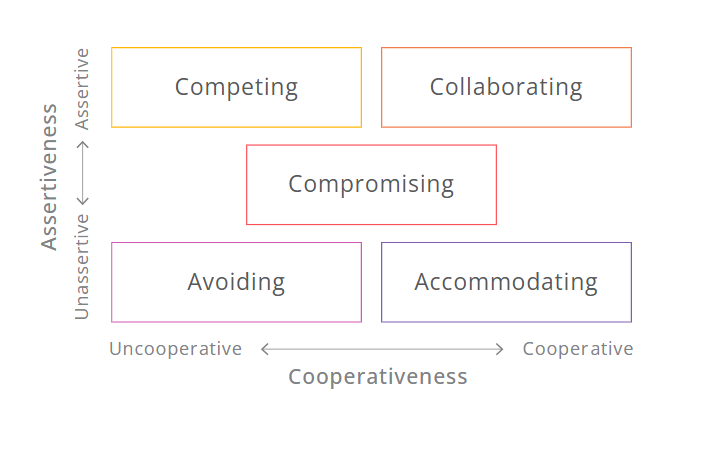Conflict-handling Avoiding Competing Accommodating Compromising Collaborating
docs
Summary

In conflict situations, individuals often exhibit different behavioral strategies based on their approach to managing disagreements. Avoiding is one strategy, and here are four others, alongside avoiding, commonly identified within conflict management models like the Thomas-Kilmann Conflict Mode Instrument (TKI):
Avoiding
- Behavior: The individual sidesteps or withdraws from the conflict, neither pursuing their own concerns nor those of the other party.
- When it's useful: When the conflict is trivial, emotions are too high for constructive dialogue, or more time is needed to gather information.
- Risk: Prolonging the issue may lead to unresolved tensions or escalation.
Competing
- Behavior: The individual seeks to win the conflict by asserting their own position, often at the expense of the other party.
- When it's useful: When quick, decisive action is needed (e.g., in emergencies) or in matters of principle.
- Risk: Can damage relationships and lead to resentment if overused or applied inappropriately.
Accommodating
- Behavior: The individual prioritizes the concerns of the other party over their own, often sacrificing their own needs to maintain harmony.
- When it's useful: To preserve relationships, resolve minor issues quickly, or demonstrate goodwill.
- Risk: May lead to feelings of frustration or being undervalued if used excessively.
Compromising
- Behavior: Both parties make concessions to reach a mutually acceptable solution, often splitting the difference.
- When it's useful: When a quick resolution is needed and both parties are willing to make sacrifices.
- Risk: May result in a suboptimal solution where neither party is fully satisfied.
Collaborating
- Behavior: The individual works with the other party to find a win-win solution that fully satisfies the needs of both.
- When it's useful: When the issue is important to both parties and requires creative problem-solving to achieve the best outcome.
- Risk: Requires time and effort, which may not always be feasible in time-sensitive situations.
Each of these strategies has its strengths and limitations, and the choice of approach often depends on the context of the conflict, the relationship between the parties, and the desired outcomes.